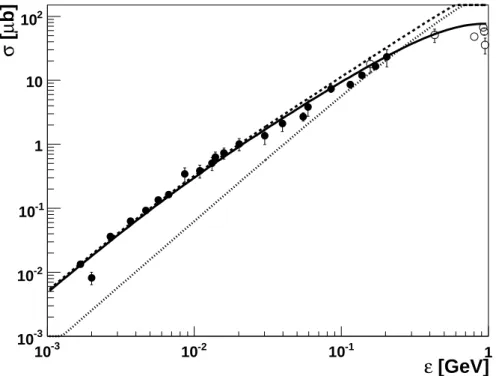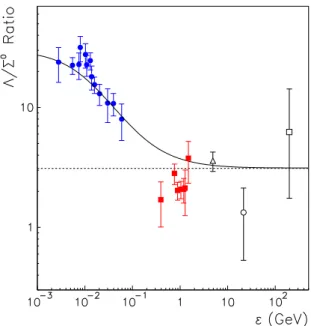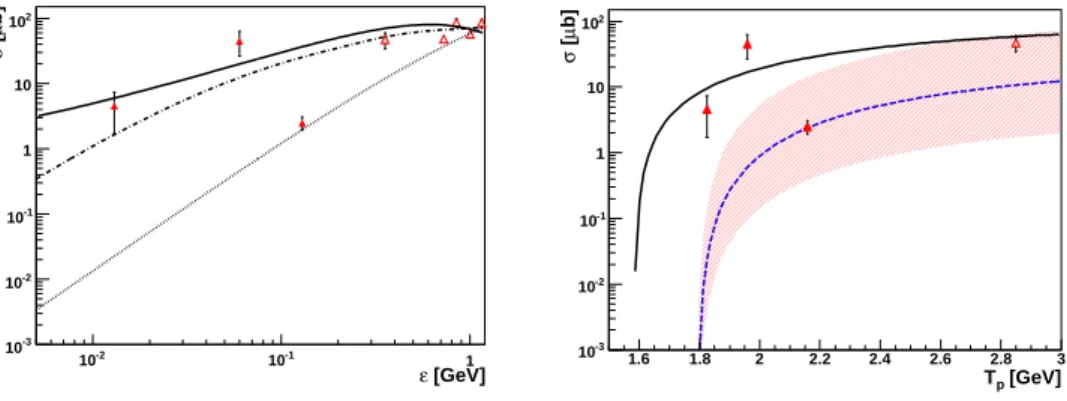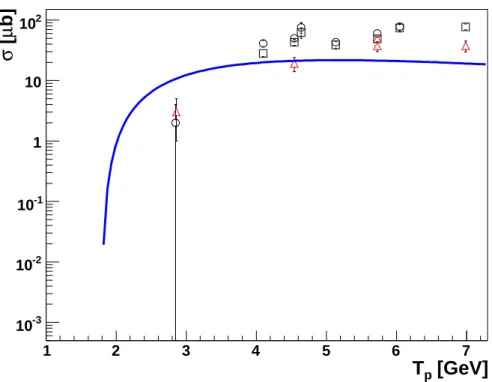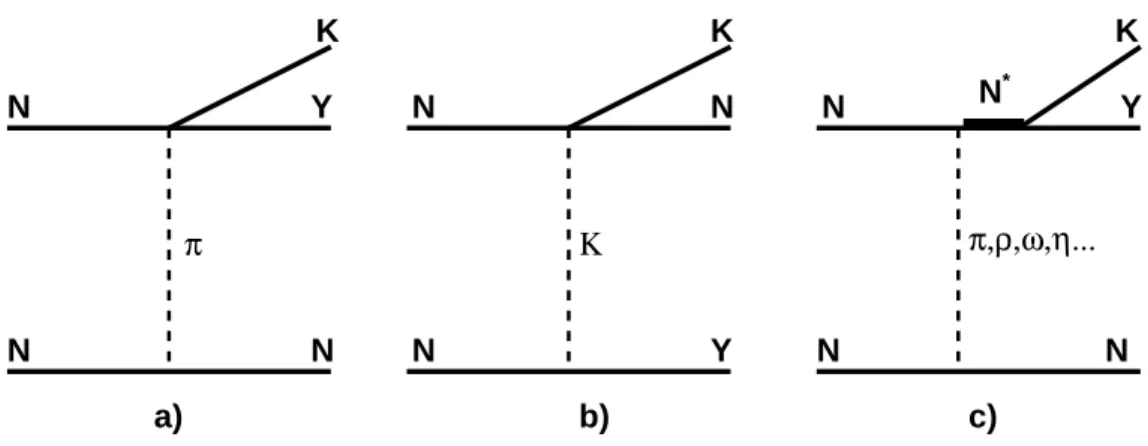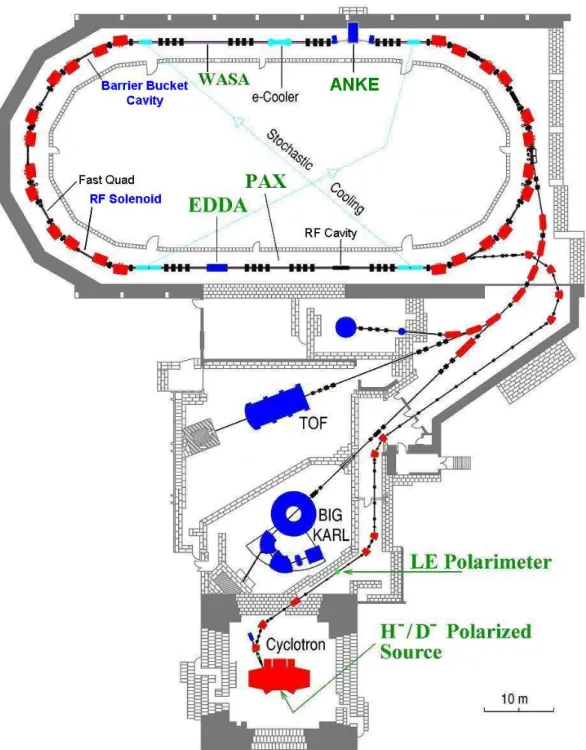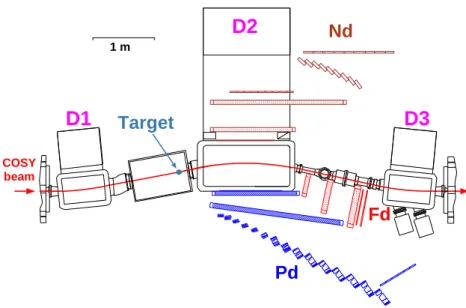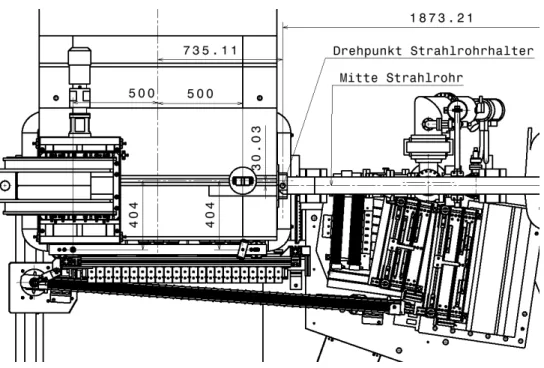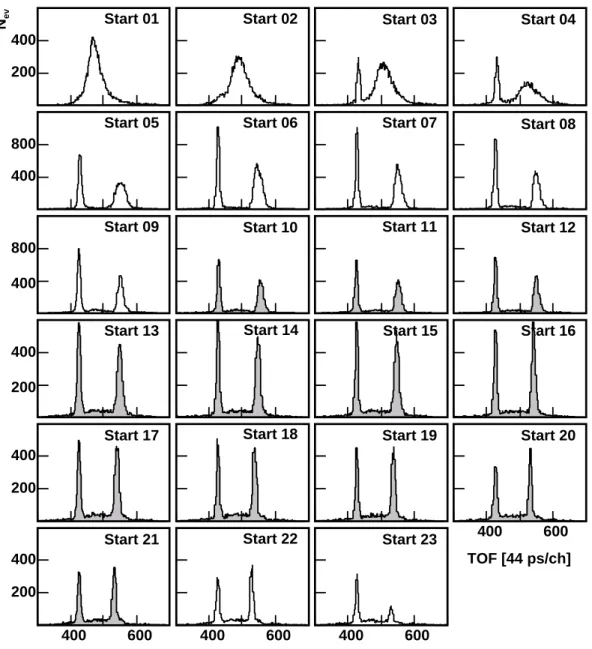Investigation of the pp → K + nΣ + reaction at the magnetic spectrometer
ANKE-COSY
Inaugural-Dissertation zur
Erlangung des Doktorgrades
der Mathematisch-Naturwissenschaftlichen Fakult¨at der Universit¨at zu K¨oln
vorgelegt von Yury Valdau
aus Sosnowy Bor (Rußland)
Forschungszentrum J¨ ulich
2009
Berichterstatter: Prof. Dr. H. Str¨oher
Prof. Dr. A. Zilges
Tag der m¨ undlichen Pr¨ ufung: 20 Oktober 2009
Contents
1 The physics case 9
1.1 Introduction . . . . 9
1.2 Experimental data on K + production in pp collisions . . . 11
1.2.1 Inclusive K + production data . . . 11
1.2.2 Bubble chamber data . . . 13
1.2.3 The pp → K + pΛ reaction . . . 13
1.2.4 The pp → K + pΣ 0 reaction . . . 17
1.2.5 The pp → K + nΣ + reaction . . . 19
1.2.6 Other hyperon production channels . . . 22
1.3 Theoretical models for the different K + production channels . 23 1.3.1 Meson exchange model . . . 24
1.3.2 Resonance model . . . 25
2 Experimental setup 27 2.1 The ANKE magnetic spectrometer . . . 27
2.2 Detection systems . . . 30
2.2.1 Positive side detection system . . . 30
2.2.2 Forward detection system . . . 31
2.2.3 Other detection systems not used in analysis . . . 32
2.3 Electronics, online triggers and data acquisition system . . . . 33
2.4 Experimental conditions during datataking . . . 34
3 Data analysis 37 3.1 Detector positions . . . 37
3.2 Experimental methods . . . 40
3.2.1 Time of flight . . . 40
3.2.2 Delayed veto technique . . . 42
3.2.3 Vertical angle cut . . . 44
3.2.4 Track selection and neighbouring counter analysis . . . 45
3.2.5 Momentum reconstruction . . . 46
3.2.6 Time calibrations . . . 47
3.3 Particle identification . . . 49
3.3.1 K + identification . . . 49
3.3.2 Identification of protons in the Fd correlated with K + 51 3.3.3 Identification of the particle in the Sd correlated with K + 54 3.4 Efficiencies . . . 55
3.4.1 Efficiencies of the MWPCs . . . 56
3.4.2 Efficiencies of the range telescopes . . . 56
3.5 Normalisation . . . 58
3.5.1 Proton-proton elastic scattering . . . 59
3.5.2 The Schottky method . . . 60
4 Extraction of the cross sections 63 4.1 Phenomenological models used in theanalysis . . . 63
4.2 Inclusive K + spectra . . . 65
4.3 Analysis of the K + p correlation events . . . 69
4.4 Analysis of the K + π + correlation events . . . 74
4.5 Extracted total cross sections . . . 77
5 Conclusions 84
6 Outlook 85
A Summary of measurements at different experimental facilities 87
Zusammenfassung
Die vorliegende Doktorarbeit beschreibt Messungen der pp → K + nΣ + - Reaktion in Schwellenn¨ahe. Die Motivation f¨ ur diese Arbeit liegt im Wesent- lichen im Fehlen von Daten zur Σ + -Hyperon Produktion in pp Kollisio- nen und insbesondere in neuen Messungen der pp → K + nΣ + Reaktion durch die COSY11 Kollaboration. In diesem mit einem Neutrondetektor durchgef¨ uhrten Experiment wurde ein ¨ uberraschend hoher Σ + Wirkungs- querschnitt, der nur schwierig mit Isospin- ¨ Uberlegungen in Einklang zu brin- gen ist, gefunden.
Das in dieser Doktorarbeit beschriebene Experiment wurde mit dem ANKE Detektor am COSY bei vier Energien nahe der Schwelle durchgef¨ uhrt.
Es beruht auf der fast untergrundfreien K + -Identifikation ¨ uber den Nachweis verz¨ogerter K + -Zerfallsprodukte sowie dem Umstand, dass unterhalb der pp → K + nΛπ + Schwelle nur der Σ + → nπ + Zerfall zur K + π + Produktion beitr¨agt. Deshalb erm¨oglicht der Nachweis von K + π + -Paaren eine eindeutige Identifikation der pp → K + nΣ + Reaktion ohne Neutrondetektor.
Die Analyse von drei simultan gemessenen Spektren wurde durchgef¨ uhrt,
um nach Hinweisen auf einen m¨oglicherweise hohen Σ + - Wirkungsquerschnitt
zu suchen. Alle bei den Experimentenergien erlaubten K + -Produktions-
kan¨ale tragen zu inklusiven K + - sowie K + p-Korrelationsspektren bei. In
den inklusiven K + - Verteilungen sind die Beitr¨age der verschiedenen Produk-
tionskan¨ale aufsummiert und k¨onnen nur durch theoretische Modelle unter-
schieden werden. In den K + p-Korrelationsspektren werden nicht nur Signale
von prim¨ar erzeugte Protonen, sondern auch durch Protonen aus Hyperon-
zerf¨allen verzeichnet. Demnach tragen Ereignisse aus Σ + → pπ 0 Zerf¨allen
zur fehlenden K + p Masse bei. Die K + π + -Korrelationen lassen die Identifika-
tion der Σ + Reaktionskan¨ale und eine Absch¨atzung des totalen Wirkungs-
querschnittes zu. Diese Methode wurde erfolgreich auf existierende ANKE-
Daten von August 2003 angewendet und f¨ uhrte zu einer Publikation in einem
referierten Journal. Die Analyse der experimentellen Daten von September
2007 f¨ uhrt zu folgenden Ergebnissen:
• Die totalen pp → K + nΣ + Wirkungsquerschnitte sind bei den vier Experimentenergien um zwei Gr¨oßenordnungen kleiner als die durch COSY11 ver¨offentlichten.
• Die totalen Λ- und Σ 0 -Wirkungsquerschnitte wurden aus K + p invariant- fehlender-Masse Spektren extrahiert und sind im Einklang mit dem Weltdatensatz, wenn man von dem Datenpunkt f¨ ur Σ 0 bei niedrigster Energie absieht, der mit technischen Problemen behaftet ist.
• Der inklusive doppelt differentielle Wirkungsquerschnitt wurde aus K + - Daten extrahiert und wird durch ein verbessertes Model, welches die totalen Wirkungsquerschnitte aus K + p- und K + π + - Analysen ber¨ uck- sichtigt, beschrieben.
Die in dieser Doktorarbeit dargestellen neuen experimentellen Ergeb-
nisse vervollst¨andigen und verbessern die Datenbasis im Bereich der Pro-
duktion von leichten Hyperonen und erlauben so die ¨ Uberpr¨ ufung weiterer
theoretischer Modelle. Der nat¨ urliche n¨achste Schritt w¨are eine Ausweitung
dieser Studien auf differentielle Observablen.
Abstract
This thesis describes measurements of the pp → K + nΣ + reaction near threshold. The work was largely motivated by the lack of data for Σ + hyperon production in pp collisions and, in particular, by recent measurements of pp → K + nΣ + by the COSY11 collaboration. The experiment performed by this group using a neutron detector reported surprisingly high Σ + cross sections that are hard to reconcile with isospin considerations.
The experiment discussed in the thesis has been performed at the ANKE- COSY facility at four close-to-threshold energies. It relies on the almost background-free K + identification using the delayed-veto technique and the fact that below the threshold for pp → K + nΛπ + there is no source of the K + π + correlations other than the Σ + → nπ + decay. Thus, the detection of K + π + pairs allows one to identify the pp → K + nΣ + reaction without the need for a neutron detector.
The analysis of three simultaneously measured spectra has been carried out, searching for any signal from a possible high Σ + cross section. All the K + production channels allowed at the energy of the experiment contribute to the K + inclusive and K + p correlation spectra. In the K + inclusive distri- butions, signals from the different production channels are summed and can only be isolated using theoretical models. In the K + p correlation spectra, there are not only signals from the direct reaction protons but also protons from hyperon decays can be observed. Thus, the signal from Σ + → pπ 0 decay contributes to the K + p missing mass. The study of the K + π + corre- lations allows one to identify the Σ + reaction channels and to estimate the total production cross section. This method has been successfully applied to existing ANKE data collected in August 2003 and resulted in a publication a refereed journal. Analysis of experimental data collected in September 2007 yielded following results:
• The pp → K + nΣ + total cross sections measured at four energies are
two orders of magnitude smaller then those reported by COSY11.
• The Λ and Σ 0 total cross sections extracted from K + p missing mass spectra are found to be in agreement with the world data, except for lowest energy data point for Σ 0 , where there were technical problems.
• The inclusive double differential cross sections extracted from the K + data are described by a refined model that uses total cross sections as obtained from the K + p and K + π + analyses.
The new experimental results presented in the thesis complete and sig-
nificantly improve the database for light hyperon production, thus allowing
one to test further theoretical models. The natural next step would be to
extend these studies towards differential observables.
Chapter 1
The physics case
Several times in the evolution of physics people have believed that the smallest building blocks of nature have been discovered. Nowadays it is accepted that these building blocks are the quarks (q) that are confined in the mesons (q q) and baryons (qqq) and that interact between each other through ¯ the exchange of gluons (g). The gluons are field bosons in the Quantum Chromo Dynamics (QCD), the theory of strong interactions. Within the framework of QCD the quarks have spin-half (fermions) and carry colour charge (“red”, “green” and “blue”) whereas the gluons have integer spins.
Currently it is believed that there are six types of quarks with non-integral values of electric charge (2/3 for u,c and t and − 1/3 for the d,s and b) and that these form the basis of all the types of particle. The presence of the s, c, t or b quark in the particle define the flavour quantum number.
In a framework of standard model, the proton and neutron, which are the elements of nature that we see around us, consist of two combinations of u and d quarks (proton = uud, neutron = udd). Thus, the production of particles with additional types of quark (strange quark s for example) in the final state particles may shed light on the structure of the nucleons and the dynamics of the strong interactions.
Strangeness production in proton-proton collisions is the subject of the present thesis.
1.1 Introduction
Since the first observation of K mesons in a Wilson cloud chamber in
1944 [1], strange particles have attracted significant attention of the particle
physics community. The first investigations of all varieties of strange parti-
cles, called V particles due to their characteristic trace in the cloud chamber,
have been carried out using cosmic rays [3]. Due to their relatively small production cross sections, even under excellent experimental conditions the accumulation of information about any type of the strange particles took a lot of time.
Even before studies with particle accelerators had become available, the strangeness quantum number was introduced by Gell-Mann and Nishijima [2]
in 1955 for the classification of a variety of particles known at that time. The basic principles of particle classification used up to now were then already developed. More detailed investigations of strangeness production became possible only after the development of more powerful accelerators.
Strangeness is a quark flavor which is produced, either from the vacuum, or from the quark-antiquark sea in the nucleons. The studies of strangeness production therefore deepen our understanding of the internal structure of the baryons. The easiest way to produce an s¯ s pair via an N N collision is the N N → K + N Λ reaction, which has a threshold at a proton beam energy of T p = 1.58 GeV. The K + N Λ final state is also interesting due to the presence of the two baryons N and Λ, the interaction of which can be studied to test the validity of the SU (3) flavour symmetry [4]. Furthermore, there are indications that excited states of the nucleons, for example the S 11 (1650), which later decay to the hyperon and kaon [5, 6], have a significant influence on strangeness production.
Strangeness is conserved in the strong interaction and, since there are no baryons with positive strangeness, the low energy K + -nucleon total cross section is small. As a consequence, K + mesons produced in the interaction have long mean free paths in the nuclear matter. Thus, studies of subthresh- old strangeness production (T N < 1.58 GeV) in pA [7] and AA [8] interaction are of special interest. In such cases kaons, which originate from the high density phase of the reaction, are not absorbed. This means that K + mesons produced in pA or AA interactions can carry information about the produc- tion mechanism, high energy components of the nuclear wave function, and possible cooperative phenomena in the nucleus.
A significant database on strangeness production in pp, pA and AA in- teractions now exists. Inclusive K + production in pA interactions has been extensively studied at CELSIUS [9], SATURNE [10], and ANKE [11] under different kinematical conditions. The ANKE pA → K + X programme has led to the accumulation of a large amount of experimental data on kaon pro- duction on different targets and a determination of the strength of the K + N potential [11]. The analysis of K + d correlation data shows the first evidence for a cluster production mechanism at subthreshold energies [12].
The production of K + , K − and K 0 mesons in AA-collisions has been stud-
ied by KaoS [13] and FOPI [14] at GSI (Darmstadt). In these experiments
kaons are used as a probe of the high density nuclear matter produced in AA collision. It was found that the K + /K − ratio is enhanced in heavy-ion collisions as compared to pp collisions [13]. This, and many other experi- mental results obtained with different beams and targets, have significantly improved our knowledge of the mechanisms of strangeness production and the understanding of matter in different phases.
This thesis presents an investigation of associated strangeness produc- tion in proton-proton collisions close to threshold. In Chapter 1.2 existing experimental data and theoretical models for the K + production in pp in- teractions are discussed. In Chapter 2 the COoler-SYnchrotron COSY and the ANKE magnetic spectrometer are described. The experimental tech- niques and analysis procedures used to obtain the experimental results are explained in Chapter 3. The procedure for extracting total cross sections and additional observables are presented in the Chapter 4. The Conclusions and Outlook are given in Chapters 5 and 6, respectively.
1.2 Experimental data on K + production in pp collisions
The total cross section for K + production in pp collisions is relatively low, which puts significant requirements onto the quality of the proton beam. The main investigations of the different K + production reaction channels have therefore been carried out at modern accelerators, such as SATURNE [15]
and COSY [16]. In the close-to-threshold regime (T thr = 1.58 GeV) there are three main K + production channels, viz. pp → K + pΛ, pp → K + pΣ 0 , and pp → K + nΣ + . The available experimental data on these three channels are discussed in Sec. 1.2.3, 1.2.4, and 1.2.5, respectively. The data on the heavy hyperon channels and four body final states with an additional π show even smaller total cross sections than those of the three body final states with light hyperons [17]. Nevertheless, one of the measurements presented in this thesis was performed slightly above the threshold for Λπ production, and therefore some details of the four body final states are presented in Sec. 1.2.6.
1.2.1 Inclusive K + production data
A number of experiments has been performed that measured inclusive
K + momentum spectra [18,19,20,15]. The experimental distributions for in-
clusive data of course contain contributions from all the strangeness produc-
tion channels that are allowed at that particular energy. The most accurate
measurements of the K + inclusive spectra were undertaken at the magnetic
Figure 1.1: The K + missing mass spectra measured at 2.3 GeV [15] compared to simulations from Ref. [22]. The K + were measured at an emission angle of 8.3 ◦ . The figure is taken from Ref. [22].
spectrometer SPES 4 at SATURNE, Saclay [15]. High resolution K + mo- mentum spectra studies were performed at 2.3 and 2.7 GeV at several K + detection angles in order to investigate the pΛ final state interaction (FSI) and search for a strange exotic dibaryon (S = − 1). Although the exotic dibaryon was not found, the K + missing mass spectra led to estimates of the scattering length and effective range parameter of the pΛ system [21].
In Ref. [22], the authors performed an analysis of all the available K +
inclusive momentum spectra, trying to isolate the contributions of the indi-
vidual hyperons by using the K + missing mass spectra. Any K + momentum
spectrum measured at some fixed laboratory angle can be converted into a
missing mass spectrum using the corresponding Jacobian. The thresholds of
individual channels can be identified in the missing mass spectra, allowing
one to investigate threshold effects. Thus, by analysing measured missing
mass spectra on the basis of simple phase space simulations, with the inclu-
sion of a pΛ final state interaction in the K + pΛ channel, it was possible to
estimate the total cross sections of individual final states contributing to the
spectra. However, the inherent uncertainty in such an analysis is relatively
large, since the K + missing mass spectra are integrated over a very small
region of phase space. In addition, the total cross sections of the Σ + and
Σ 0 production are superimposed on the much bigger contribution from the pp → K + pΛ reaction. This makes the extraction of Σ cross sections very dependent on the models used for the pp → pK + Λ reaction. It is therefore hard to draw very firm conclusions about Σ production from such data. A comparison of the simulations with the inclusive K + spectra measured at 2.3 GeV is presented in Fig. 1.1.
1.2.2 Bubble chamber data
The bubble chamber experiments that were done at relatively high ener- gies and suffer from low statistics and poor resolution [5, 23]. In most of the measurements only the total cross sections of the well identified three and four body reaction channels have been estimated. A compilation of the total cross sections for the different reaction channels, measured at relatively high energies with bubble chambers, is presented in Ref. [23]. However, some dif- ferential observables with low statistics have also been published at relatively high energy (5.13 GeV) [5]. The deviation of the measured differential mass spectra for pp → K + pΛ and pp → K + pΣ 0 from pure phase space was in- terpreted as indications for strong final state interactions and the significant influence of resonances in the production mechanism.
More detailed investigations of the three lightest hyperon production channels have been carried out using counter techniques at the COSY storage ring.
1.2.3 The pp → K + pΛ reaction
The pp → K + pΛ reaction is the most investigated of all the different K + production channels. Before COSY began operation, only one data point from a bubble chamber experiment was available in the threshold region [24].
The COSY11 [25, 16, 26] and COSY-TOF [27, 6] collaborations performed series of measurements of the total cross section for Λ production at different energies. COSY11 measured close to threshold by reconstructing the Λ in the K + p missing mass distribution, whereas COSY-TOF performed exclusive measurements of the reaction channel, registering all the particles in the final state. The dependence of the total cross section on the excess energy ε is presented in Fig. 1.2.
The analysis of the available experimental data on the pp → K + pΛ reac-
tion using a simple phase space model indicates the presence of a strong pΛ
final state interaction [29]. The parameters of the pΛ final state interaction
(FSI) are, however, poorly known [21] due to the absence of high quality pΛ
scattering data. Values of the singlet (a s ) and triplet (a t ) scattering lengths
[GeV]
ε
10 -3 10 -2 10 -1 1
b] µ [ σ
10 -3
10 -2
10 -1
1 10 10 2
Figure 1.2: The total cross sections of the pp → K + pΛ reaction as a function of excess energy. Measurements performed at COSY are shown by closed circles [25, 16, 26, 27, 6, 28]; open circles represent results from other experi- mental facilities [24,23]. The parametrisation of the three body K + pΛ phase space with a constant matrix element is shown by the dotted line, the same dependence after correction for the pΛ FSI by the dashed line. The three body phase space corrected for the final state interaction and matrix element energy dependence is shown by the solid line [29].
have been determined using the 378 Λp scattering events reported in Ref. [30], leading to the following parameters:
a s = − 1.8 { +2.3 −4.2 fm and a t = − 1.6 { +1.1 −0.8 fm. (1.1) The corresponding effective range parameters vary from 0 to 16 fm. This shows that the parameters of the pΛ FSI are not accurately determined by the experimental data and can vary in different analyses.
The authors of Ref. [29] proposed to parameterise the energy dependence
of the total cross section in terms of pure three-body phase space with a con-
stant matrix element and strong final state interaction implemented using the
Jost function. In their later analysis [31] this parametrisation was improved by using an energy dependent matrix element. The results of these parame- terisations are compared with the experimental data in Fig. 1.2. Using this parametrisation the Λ total production cross section can be determined with a precision of ∼ 10% for excess energies up to 1 GeV.
Very little is known up to now about the production mechanism and most of differential observables have only been presented in terms of PhD theses;
for details see Appendix A. Dalitz plots and their corresponding projections measured at 2.75 and 2.85 GeV at COSY-TOF are presented in Refs. [27, 6].
The analysis of Dalitz plots performed in Ref. [6] and continued in Ref. [32]
leads to the conclusion that the production of the K + pΛ final state proceeds via different N ∗ resonances (N (1650), N (1710) and N(1720)). Furthermore, it was found in Ref. [32] that the contributions of the different resonances to the production mechanism changes with beam momentum. On the basis of the Dalitz plot analysis it was concluded [6] that close-to-threshold Λ production take place via π exchange and that the pΛ final state interaction has a significant influence on all the observed distributions [6]. In Ref. [32]
it is suggested that up to the excess energy of 282 MeV the contribution of the higher partial waves is very small, though the measured angular spectra show some anisotropy for all three final particles. The parameters of the partial wave analysis of angular distributions measured by COSY-TOF are collected in Appendix. A.
There is very little information on polarisation observables for the pp → K + pΛ reaction in the close-to-threshold regime. From high energy experi- ments it is known that
• the Λ produced are polarised perpendicular to the production plane and that the polarisation is negative;
• the polarisation increases linearly with the transverse momentum p T of the Λ hyperon;
• the Λ polarisation is almost independent of the proton beam momen- tum from 12 to 200 GeV/c.
The Λ polarisation at 2.75 GeV/c has been measured as a function of the momentum transfer [27]. In addition there are more measurements of the Λ polarisation performed with the COSY-TOF detector that have been reported in PhD theses [33, 34, 35, 36, 37, 38]. The effect of Λ polarisation is still not explained by theoretical models.
There is only one measurement of the D N N parameter using polarised
proton beams of 3.67 and 2.94 GeV/c performed by the DISTO collabora-
tion [39, 40]. The result of the measurements at 3.67 GeV/c as a function of
0.0 0.5 1.0 x F
-0.4 0.0 0.4
D NN
DISTO 3.67 GeV/c (exclusive) DISTO 3.67 GeV/c (semi-inclusive)
![Figure 1.1: The K + missing mass spectra measured at 2.3 GeV [15] compared to simulations from Ref](https://thumb-eu.123doks.com/thumbv2/1library_info/3702250.1506069/12.892.313.639.189.509/figure-missing-mass-spectra-measured-gev-compared-simulations.webp)
